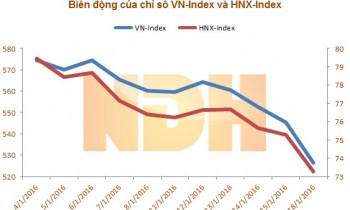After a rough start for 2016, here’s what investors can do to deal with what’s ahead
If January signaled what the stock market is going to be like in 2016, fund investors could face a gut-wrenching year.
Worries about China and the global economy, a surging dollar and oil’s collapse helped send the S&P 500 index down 5.07% in January, the market’s worst performance for that month since the 2009 financial crisis. The poor start came after the index’s six-year winning streak ended in 2015. What’s more, stocks may not have seen the lows for this correction yet, money managers caution.
But big market moves present opportunities, and there are things that investors might do—or avoid doing—to enhance future returns, professionals say. With valuations now lower, it might make sense to add to current stock positions or diversify to trim overall risk in a portfolio, they say.
Still, investors should think in terms of tuning up, not tearing up, portfolios, says Daniel Culloton, associate director of fund analysis at Morningstar Inc. MORN, +1.69% Because events that drive trading can be transitory, most people are better off “setting a long-term plan, evolving it and then sticking with it,” he says.
Here is a closer look at seven domestic and global events affecting stocks—including oil, China and the U.S. election—and how investors might want to play them, now that the overall market isn’t shrugging off every challenge.
1. The slide in oil
Crude oil’s plunge has fanned fears of global recession, a financial squeeze for oil-producing countries and bond defaults by some debt-laden U.S. producing companies.
With energy stocks sharply lower, is now the time to step in? It is impossible to gauge whether those stocks are attractively valued without knowing where oil is headed from here, says Eddie Perkin, chief equity investment manager at Eaton Vance Investment Management, Boston. If investors want to venture in, a sensible strategy might be “dollar-cost averaging,” or making modest purchases at regular intervals regardless of where prices stand, he says. That would lower the risk of mistiming purchases.
But don’t rush to buy, adds New York-based adviser Richard Bernstein, former chief investment strategist at Merrill Lynch & Co. Typically, he says, as any market nears a cyclical bottom, the last move along the way can be steep. Individual investors often do better by being late to the party rather than early, he adds.
2. China’s slowing growth
Although it is the world’s second-largest economy, behind the U.S., China’s direct impact on U.S. stocks is modest: S&P 500 companies probably get less than 8% of revenue from all of Asia, estimates S&P Global Market Intelligence and SNL, a division of McGraw Hill Financial. MHFI, +0.15%
Still, because China news can drive big moves in markets, it is difficult to find stocks that are totally unaffected, says Omar Aguilar, chief investment officer for equities at Charles Schwab Investment Management. But the fundamental impact might be less for small-cap or midcap stocks with a domestic focus than for big, multinational companies with a presence in Asia, Aguilar says.
BlackRock Inc.’s BLK, -0.53% iShares unit, Vanguard Group and State Street Global Advisors all offer ETFs that trade the Russell 2000, a benchmark for small-cap stocks.
For investors who want a professional manager, some active funds have a strong domestic focus. Diamond Hill Small-Mid Cap DHMIX, +0.00% which holds Morningstar’s top gold rating, owns stocks such as Jarden Corp., JAH, +0.33% a maker of outdoor equipment and kitchen appliances, and medical-device maker Boston Scientific Corp. BSX, -0.29%
3. The corporate-profits recession
With markets so fixated on oil and China, it is unclear whether corporate profit reports are having as much impact as usual, says Sam Stovall, U.S. equity strategist at S&P Global Market Intelligence and SNL. But if investors are paying attention, they have likely noticed that the news has been dismal.
Profits for the fourth quarter of 2015, now being reported, could be off as much as 6% on average from a year ago, led by an expected 60% drop in the energy sector, Stovall says. Besides the energy price collapse, a major headwind is the strong dollar, which has made U.S. goods less competitive in overseas markets.
But investors shouldn’t bail out of stocks merely because of worries about the latest quarterly profits, Stovall says. One reason, he says, is energy stocks are the prime reason for the broad decline. If oil prices level off later this year, comparisons would look much better. Fourth-quarter 2016 profits actually could post a double-digit rise, he adds.
4. Volatility and shifting sentiment
It can be scary to own stocks when markets are gyrating. Fear often prompts people to make decisions that haunt them later, professionals say. Generally, people who can’t commit to a position in stocks for, say, five years shouldn’t own them, says William Barker, a fund manager at Motley Fool Funds.
Investors who want a more conservative strategy could consider shares in big blue chips, particularly those that pay regular dividends, have dominant positions in their markets and strong balance sheets. Those tend to be less volatile.
A fund that focuses on large-cap companies with a record of strong financial performance is Jensen Quality Growth, JENRX, +0.06% which gets Morningstar’s silver rating, the second highest. Morningstar’s Culloton also cites Vanguard Dividend Growth fund, VDIGX, +0.14% which focuses on large-cap companies that consistently pay or raise dividends, such as Coca-Cola Co. and McDonald’s Corp. It holds Morningstar’s gold rating.
Another such fund is Royce Special Equity, RYSEX, +0.46% a small-cap fund. Culloton says its manager, Charles Dreifus, is a “very meticulous stock picker with very high standards who delves into the accounting of all the companies he wants to own and will avoid sectors he thinks he can’t understand well.” The fund holds a gold Morningstar rating.
5. Long-term macroeconomic trends
Besides reacting to daily news, stocks also are being buffeted by long-term trends, says Jack Rivkin, chief executive of Altegris Investments Inc. in La Jolla, Calif., and former head of world-wide equities at Lehman Brothers. Among those trends, he says, is the continuing transition to a services-focused economy in the U.S. While declining to name stocks, Rivkin says investors should look for growth in service areas such as restaurant and hotel chains, cloud-computing concerns, professional-services firms and financial companies, among others.
Bernstein, the New York-based adviser, points to the consumer sector as another area of strength in the U.S. economy. Two popular ETFs that invest in less-volatile securities recently held about a fourth of their portfolios in the consumer sector: PowerShares S&P 500 Low Volatility SPLV, +0.11% and iShares MSCI USA Minimum Volatility USMV, +0.07%
6. The U.S. election
Investors hate uncertainty, notes Stovall of S&P Global Market Intelligence. And because uncertainty rises whenever the nation is preparing to elect a new leader, stocks often have a negative year.
Since World War II, the decline has averaged minus 1.4% in the eighth year of presidential terms, Stovall calculates.
But investors who stand pat can get rewarded. In the first year of each new presidential term, stocks have posted average gains of 6.2%. The rise is even stronger in the first year of a president’s second term, averaging nearly 10%.
Will those trends hold this year and next? Market strategists say it is too early to tell, because the field of candidates remains crowded and poll results have been shifting significantly.
7. The Fed and interest rates
Over the past three years, hints that the Federal Reserve was considering its first rate increase since the 2008-09 financial crisis sometimes rattled markets. But after policy makers finally nudged short-term rates up by a modest 0.25 percentage point in December, it currently looks as though the Fed is unlikely to make more than one rate increase in 2016, says Rick Rieder, a top fixed-income strategist and bond-fund manager at BlackRock.
Concerns about further tightening have mostly dissipated because of an apparent slowing in U.S. growth and other events that have caused stocks to drop sharply, says Rieder.
If the Fed does raise rates slowly from here, it would be bullish for stocks, equity strategists say, because it might limit further gains in the dollar, helping U.S. exports. If the dollar were to level off, that would aid sectors that have been under pressure, such as manufacturing, says Eaton Vance’s Perkin. Conversely, if the dollar were to head higher, he says, that would further pressure oil prices and weaken appetites for stocks.
MarketWatch




